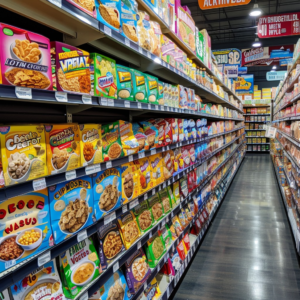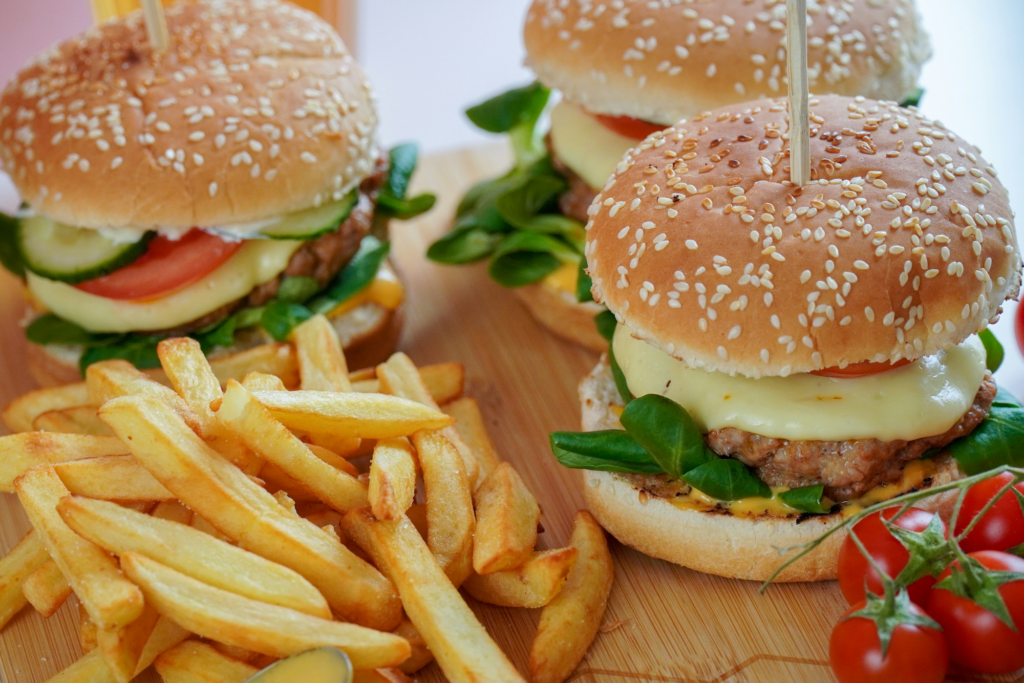As an athlete and high-achiever, convenience is a way of life. Whether you’re running from a hard workout at the gym to a long day at the office or from a power Vinyasa yoga class to picking up your kids at school, I’d bet you’re always on the go. And likely trying to fuel along the way.
Enter pre-packaged foods. Items that are easy to throw in your bag and can be scarfed down on the way to your next destination. And you’re not alone. In a world of convenience, where ready-to-eat meals and packaged snacks dominate our grocery store shelves, we’re facing an uncomfortable truth. It turns out that the foods designed to make our lives easier are also slowly degrading our health.
Sports and Nutrition
As an athlete myself, who’s been in the world of sports since college, I’ve seen the wave of nutritional advice change more frequently than Halsey’s hairstyles. I remember when many of the public figures I followed in bodybuilding, powerlifting and ultrarunning would proudly post photos of the gigantic scoops of ice cream, massive pizzas and burgers, and general “junk food” they’d consumed that day next to a caption saying something like “you can eat like this and still be ripped”.
While I can’t argue with that outcome, because many of them were indeed physically jacked, I believe research is now showing that the truth was only skin deep. While they looked “healthy” by appearance, the impact of these foods goes far beyond the simple macronutrient breakdown.
“A Calorie in, a calorie out”
More and more research has debunked the previously supported claim that “a calorie in, a calorie out”. Growing literature is supporting the concept that “a calorie eaten is not a calorie burned”. Research is challenging decades of weight management advice and opening a critical conversation about the quality of our calories, not just their quantity. Given the high caloric need for many athletes, it’s easy to see why we may gravitate to calorically dense packaged foods.
I’ll be the first to raise my hand and admit that I used to be a frequent visitor to our doctors’ lounge, where I could snack on an endless supply of donuts, croissants and packaged muffins. I knew with the 40-50 miles I accrued on the roads each week, I would easily burn through the 350 calories of glazed donut sticking between my fingers. The piece I didn’t figure in at the time was the effect the processing and ingredients of these foods was having on my body.
What Are Ultraprocessed Foods?
Ultraprocessed foods (UPFs) are industrial formulations made predominantly from substances extracted from whole foods—such as oils, sugars, and modified starches. Unfortunately, once processed, these foods contain little to no intact remaining whole foods. These products typically undergo multiple processing steps and often include additives like preservatives, emulsifiers, artificial colors, and flavors that make them hyper-palatable, convenient, and last forever.

Generally, UPFs have minimal nutritional value and a high content of added sugars, unhealthy fats, and sodium. They include foods like packaged snacks, soft drinks, instant noodles, chicken nuggets, frozen meals, mass-produced breads, breakfast cereals, and most fast foods.
The NOVA food classification system was developed by researchers at the University of São Paulo to helpfully classify foods into 4 categories from their whole, natural state to an ultraprocessed state (that barely resembles the original form of the food).
- NOVA 1: Unprocessed or Minimally Processed Foods: Food in its original state or having undergone minimal processing like washing, peeling, or freezing. Examples including fresh or frozen fruits and vegetables, grains, legumes, milk, yogurt, natural cheeses, fresh meat and fish, eggs, nuts, seeds, and spices.
- NOVA 2: Processed Culinary Products: Primarily includes cooking ingredients derived from NOVA 1 foods like salt, oil, sugar, or vinegar.
- NOVA 3: Processed Foods: These foods are made by combining food products from NOVA 1 and NOVA 2, like freshly baked breads, canned vegetables, or cured meats.
- NOVA 4: Ultraprocessed Foods: Industrial formulations made mostly or entirely from substances derived from foods and additives, with little to no intact whole foods like packaged snacks, frozen meals, and fast food.
How Ultraprocessed Foods Affect Your Body
When you eat ultraprocessed foods (UPFs), you’re not just ingesting calories—you’re introducing a complex array of compounds that your body is not designed to handle in large quantities. The result? A cascade of inflammatory responses that can affect virtually every system in your body.
Additionally, Research from the National Institutes of Health (NIH) has shown that people eating ultraprocessed diets consume approximately 500 more calories per day than those eating minimally processed foods. This is the cae even when both diets contain the same amounts of sugar, fat, fiber, and macronutrients. This suggests there’s something intrinsically different about how our bodies process and respond to these foods.
The Standard American Diet
The statistics are sobering. According to research published in BMJ Open, ultraprocessed foods make up nearly 60% of the average American’s daily calories and 90% of their added sugar intake.
As an athlete, you probably don’t consider yourself an “average” American with a BMI meeting the standard definition of obese. However, that doesn’t mean that the impact of the foods your eating isn’t any less disastrous in your body. And it may even be possible that you’re consuming a high percentage of ultraprocessed foods (UPFs) and don’t even realize it. Read on to see what UPFs are sneaking their way into your diet.
What exactly are the culprits?
Processed Sugars: The Sweet Deception
The average American consumes 68 grams (or 17 teaspoons) of added sugar daily. That’s nearly 4 times the 24 grams (or 6 teaspoons) recommended by the American Heart Association. I was personally surprised by the amount of added sugar that I was unassumingly consuming once I began looking at nutrition labels. It wasn’t from pouring 10 packets of sugar into my coffee in the morning either. It was hiding in foods like flavored yogurt, coffee creamer, and protein bars. As I began reading labels, I learned that added sugar is hidden in many foods to make them palatable and, often times, “addictive“.
What is the problem with added sugar?
Added sugars represent one of the most insidious components of the Standard American Diet. Unlike naturally occurring sugars in fruits and vegetables—which come packaged with fiber, vitamins, minerals, and phytonutrients that counter the effect of the sugar when consumed—added sugars enter the bloodstream rapidly. In response, the pancreas is forced to release large amounts of insulin, which over time, can lead to insulin resistance.
The liver, overwhelmed by these sugars, converts excess amounts to fat, contributing to non-alcoholic fatty liver disease. Meanwhile, these sugars bond with proteins in the bloodstream to form advanced glycation end products (AGEs), which damage blood vessels and accelerate aging at the cellular level. Sugars also alter gut microbiota, favoring pro-inflammatory species, and directly activate inflammatory signaling pathways.
A 2023 study in the Journal of the American College of Cardiology found that each daily serving of sugar-sweetened beverages was associated with an 18% increased risk of inflammatory markers in the bloodstream regardless of how much you exercise. Growing evidence has also shown that added sugars activate the same reward pathways in the brain as certain drugs, highlighting its “addictive” nature.

Where is the sugar hiding?
- Yogurt
- Condiments like ketchup and BBQ sauce
- Spaghetti sauces
- Salad dressings
- Breads
- Protein bars
- Breakfast cereals and granolas
- Peanut butter
- Coffee drinks
- Sports drinks
- Cold press juices
- Pre-made smoothies
What to do about it?
Read labels. Every food product is required to have an ingredient and nutrition label. Read the nutrition label for added sugar. Track your sugar intake for a few days to get a sense of how much you’re consuming daily. The goal should be to consume less than 24 grams (or 6 teaspoons) of daily added sugar for women and 36 grams (or 9 teaspoons) for men.
Another guide is to look at the % daily value of added sugar. Choose foods with less than 5% daily value (DV). If you see that a food has greater than 20% DV of added sugar, it’s in your best interest to put it back on the shelf.
Refined Grains: The White Lie
Refined grains like white bread, pasta, and rice have been stripped of their fiber and nutrient-rich components. These foods can cause rapid blood sugar spikes, increased oxidative stress, reduced beneficial gut bacteria, and disrupted satiety signals.
Research from the American Journal of Clinical Nutrition has shown that replacing refined grains with whole grains can reduce inflammatory markers by up to 38% in just 8 weeks.
Vegetable and Seed Oils: The Omega Imbalance
 Our modern diet has dramatically shifted our omega-6 to omega-3 ratio from the evolutionary norm of roughly 1:1 to often 20:1 or higher. This shift is primarily due to processed seed oils. For example, the intake of soybean oil has increased 1,000-fold in the last century.
Our modern diet has dramatically shifted our omega-6 to omega-3 ratio from the evolutionary norm of roughly 1:1 to often 20:1 or higher. This shift is primarily due to processed seed oils. For example, the intake of soybean oil has increased 1,000-fold in the last century.
Research is still unfolding regarding the role of vegetable and seed oils in inflammation. In the interest of simplicity, the main concern is that seed oils are high in linoleic acid. Linoleic acid is a precursor to arachidonic acid, which activates pro-inflammatory pathways. As the imbalance of intake shifts towards higher amounts of omega-6 fatty acids, a competition ensues between the omega-3 anti-inflammatory and omega-6 pro-inflammatory pathways.
It’s possible that vegetable and seed oils are not inherently bad for you. However, these oils are often used in ultraprocessed foods, which may be the real problem. Furthermore, oils, when heated to their smoking point, oxidize and release free radicals, which is a catalyst for inflammation in the body. Choosing oils that can withstand higher temperatures like olive oil, avocado oil, and safflower oil will reduce your exposure to additional inflammatory compounds.
Artificial Additives: The Chemical Cocktail
Emulsifiers, stabilizers, and texturizers are ubiquitous in ultraprocessed foods (UPFs). Common emulsifiers like carboxymethylcellulose and polysorbate-80 have been shown to alter gut bacteria and intestinal barrier function. They can trigger inflammation by activating specific immune pathways.
A 2023 cohort study following over 90,000 adults found that higher consumption of foods containing emulsifiers was associated with increased inflammatory markers and higher rates of stroke and cardiovascular disease. Further data from this study identified a connection between intake of these artificial additives and cancer. By avoiding UPFs altogether, you’re already improving your gut health and reducing your risk of metabolic dysfunction.
Food Dyes: The Colorful Concern
Synthetic food colorings do more than make foods visually appealing. Red 40, Yellow 5, and Yellow 6 (the most common in the U.S.) have been linked to inflammatory responses and promote oxidative stress at the cellular level. European regulatory bodies now require warning labels on foods containing certain dyes. While US regulations are currently more lax, the US FDA did just revoke authorization for FD&C Red No. 3 as of 2025. FD&C Red No. 3 is primarily used in foods like candies, cakes and cupcakes, cookies, frozen desserts, frostings and icings, as well as some supplements and oral pills.
In general, it’s best to avoid regular consumption of foods that contain these dyes. Instead, opt for foods that contain natural colorants such as beetroot, turmeric, annatto, or saffron.
Preservatives: The Double-Edged Sword
While preservatives prevent food spoilage and increase shelf life, many come with unintended consequences. Given the number of preservatives that currently find their way into our food, this section deserves its own dedicated post (coming soon).
For now, common preservatives linked to inflammation and/or cancer include:
- sodium nitrite/nitrate commonly found in processed meats,
- sodium benzoate used in ultraprocessed foods (UPFs) and beverages to extend shelf life,
- butylated hydroxyanisole (BHA) and butylated hydroxytoluene (BHT) found in UPFs and skin care products,
- sulfites used to preserve dried fruits and wines,
- monosodium glutamate (MSG) found in UPFs, fast foods and Asian cuisine, and
- carrageenan, an emulsifier commonly found in UPFs.
The Inflammation Connection: Why It Matters
The Nutritional Inflammation Connection
Dietary patterns play a pivotal role in modulating inflammatory responses. Ultraprocessed foods (UPFs) don’t just provide empty calories. UPFs actively trigger inflammatory pathways through disruption of gut microbiome, increased oxidative stress, activation of pro-inflammatory immune cells, and impairment of cellular repair mechanisms.
Quantifying the Impact
A landmark 2018 study in The BMJ found that each 10% increase in UPF consumption was associated with a 12% increased overall risk of cancer, significant elevation in systemic inflammatory markers, and reduced immune system efficiency.
Breaking the Cycle: Practical Steps
The good news is that diet-induced inflammation can be remarkably responsive to change. Studies demonstrate that individuals who transition to whole food-based diets can reduce CRP levels by up to 40%, improve insulin sensitivity, enhance immune function, and support cellular repair mechanisms.
- Focus on whole foods: The majority of your diet should come from whole fruits, vegetables, whole grains, legumes, nuts, seeds, and quality animal products.
- Read ingredient lists, not just nutrition facts: The longer the list, the more likely it contains inflammatory compounds.
- Cook more meals at home: This gives you control over ingredients and processing methods.
- Gradually replace inflammatory oils: Choose olive oil, avocado oil, and other minimally processed fats.
- Increase omega-3 intake: Consume more fatty fish, walnuts, flaxseeds, and chia seeds.
- Prioritize diversity in plant foods: Eating of the color of the rainbow and varying the plant foods you eat will make for a healthier gut microbiome.
- Consider intermittent food quality “breaks”: Even short periods of clean eating can reduce inflammatory markers.
- Apps: Use apps like Yuka to quickly assess the quality of packaged foods if you need to make these choices, because let’s be real, life is fast-paced, and you need to keep up.
Take Away
Reframing Your Relationship with Food
The evidence is clear. Ultraprocessed foods (UPFs) are not merely “empty calories.” They are active participants in creating and sustaining inflammation in our bodies. The addictive nature of these products, combined with their convenience and ubiquity, creates a challenging environment for those seeking better health.
By understanding that a calorie burned is fundamentally different from a calorie eaten—that the source and quality of your nutrition matters profoundly—you can begin to make more informed choices that support your body’s natural anti-inflammatory systems.
The journey away from UPFs isn’t about perfection; it’s about progress. Each whole food choice represents an investment in reducing your inflammatory burden and supporting your body’s remarkable capacity for healing.








